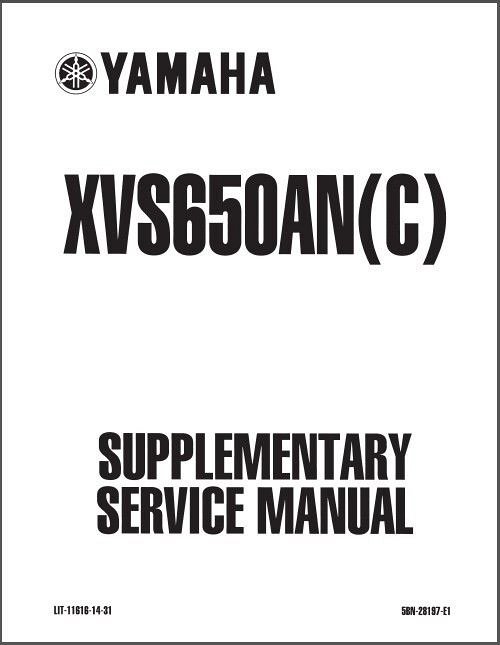Dragstar 650 Service Manual
The 1997-2011 Yamaha Drag Star, V-Star repair manual by Haynes, covers models indicated, including: Europe XVS Drag Star models:. Yamaha XVS650, 1997-2005. Yamaha XVS650A Classic, 1998-2008. Yamaha XVS1100, 1999-2006.

Yamaha Drag Star 650 Service Manual
Yamaha XVS1100A Classic, 2000-2008 U.S. XVS V-Star models:. Yamaha XVS650 Custom, 1998-2011. Yamaha XVS650A Classic, 1998-2010. Yamaha XVS650S Silverado, 2003-2010. Yamaha XVS1100 Custom, 1999-2009.
Yamaha XVS1100A Classic, 2000-2009. Yamaha XVS1100S Silverado, 2002-2009 The Haynes 4195 - Yamaha XVS650 / XVS1100 repair manual incorporates step-by-step procedures, hundreds of diagrams and COLOR wiring diagrams to help the DIY mechanic succeed with maintenance, service and repair projects. Haynes manuals are based on complete teardown and rebuilds of the exact model(s) covered so you can be sure that you are referencing expert service procedures. Book Excerpt: 1997-2011 Yamaha XVS650, XVS1100, Drag Star, V-Star Repair Manual ENGINE, CLUTCH AND TRANSMISSION 650 MODELS MAIN AND CONNECTING ROD BEARINGS GENERAL INFORMATION. Even though main and connecting rod bearings are generally replaced with new ones during the engine overhaul, the old bearings should be retained for close examination as they may reveal valuable information about the condition of the engine.
Bearing failure occurs mainly because of lack of lubrication, the presence of dirt or other foreign particles, overloading the engine and/or corrosion. Regardless of the cause of bearing failure, it must be corrected before the engine is reassembled to prevent it from happening again. When examining the bearings, match them with their corresponding journal on the crankshaft to help identify the cause of any problem. Note that the main bearings are pressed into the crankcase halves and should only be disturbed if new ones are to be fitted. Dirt and other foreign particles get into the engine in a variety of ways.
They may be left in the engine during assembly or they may pass through filters or breathers, and then get into the oil and from there into the bearings. Metal chips from machining operations and normal engine wear are often present.
Gace early childhood study guide. Get free online GACE early childhood education practice test questions. Study for your GACE early childhood education test with our free GACE early childhood. Combined Test I and Test II: 2. The GACE Early Childhood Education assessment is designed to measure the professional knowledge of prospective teachers of. GACE Early Childhood Education: Study Guide for the GACE ECE Exam [GACE Early Childhood Exam Team] on Amazon.com. *FREE* shipping on qualifying. This assessment can be challenging, so we created the GACE Early Childhood Education Practice Test to help you learn about the subjects that you will see on. Early Childhood Education. The Early Childhood Education assessment consists of two subtests; a combined version of the tests is also offered. Test I (001).
Abrasives are sometimes left in engine components after reconditioning operations, especially when parts are not thoroughly cleaned using the proper cleaning methods. Whatever the source, foreign objects often end up imbedded in the soft bearing material and are easily recognized. Large particles will not imbed in the bearing and will score or gouge the bearing and journal. The best prevention for this type of bearing failure is to clean all parts thoroughly and keep everything spotlessly clean during engine assembly.
Regular oil and filter changes are also essential. Lack of lubrication or lubrication breakdown has a number of interrelated causes. Excessive heat (which thins the oil), overloading (which squeezes the oil from the bearing face) and oil leakage or throw off (from excessive bearing clearances, worn oil pump or high engine speeds) all contribute to a breakdown of the protective lubricating film.
Blocked oil passages will starve a bearing of lubrication and destroy it. When lack of lubrication is the cause of bearing failure, the bearing material is wiped or extruded from the steel backing of the bearing. Temperatures may increase to the point where the steel backing and the journal turn blue from overheating. FRAME, SUSPENSION AND FINAL DRIVE STEERING STEM REMOVAL. Remove the fuel tank to avoid damaging its paintwork (see Chapter 3). If the fork top yoke is going to be fully removed from the machine, remove the handlebar bracket nuts, and then separate the cable guide from the top yoke and free the wiring from the clips on its underside (see illustrations 5.4 and 5.10).
Note that, if required, the fork top yoke can be displaced with the handlebars in place. Note the alignment between the top of the fork leg and the top yoke, then loosen the fork clamp bolts in the top yoke (see illustration 6.6). Remove the steering stem nut and washer, then lift off the top yoke (see illustration). Remove the front forks (see Section 6). Remove the headlight unit and front turn signal assemblies (see Chapter 8). Remove the lock washer, noting how it fits, then unscrew and remove the locknut using, if necessary, either a C-spanner or a drift located in one of the notches (though it shouldn't be tight and can probably be undone with your fingers)(see illustrations).

Remove the rubber washer (see illustration). Subject: 1997, 1998, 1999, 2000, 2001, 2002, 2003, 2004, 2005, 2006, 2007, 2008, 2009, 2010, 2011 Yamaha XVS650, XVS1100, Drag Star, V-Star service, maintenance, repair.
ISBN-10: ISBN-13: 697 Haynes 4195.
Complete service repair workshop manual for the: Yamaha Dragstar V Star 650 XVS650 XVS65 Classic Silverado Custom This is the same manual motorcycle dealerships use to repair your bike.
Comments are closed.